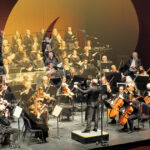Concert Review: Beethoven, Bartok and Brahms Concert
This review appeared in the March 2012 Albuquerque Journal. Reprinted with kind permission.
by D.S. Crafts
Saturday night at the Symphony—now the New Mexico Philharmonic—is always an affair of particularly high spirits. No more so than when one our own is featured. Violist Kimberly Fredenburgh stepped into the limelight to perform the Bartok Viola Concerto led by guest conductor Victor Yampolsky. Beethoven’s Overture to Fidelo and the Brahms Second Symphony completed the program.
Conductors frequently rearrange the seating of the string section, but this layout was entirely new to me. While the two violin sections sat facing each other, as Guillermo Figueroa prefers, the double basses were directly behind the first violins with the cellos in the center.
Bartok’s Viola Concerto is something of a Frankenstein in that it was cobbled together from sketches. Before his death Bartok claimed the piece was finished, but when his friend and colleague Tibor Serly attempted to assemble the notes, the task proved anything but straightforward. Consequently the piece has sometimes been called into question. The first two movements may be uneven, but there are clear sections of Bartok in his final compositional phase. The final Allegro vivace is the most Hungarian in character and also the most successful.
Fredenburgh, a well-deservedly popular favorite, was warmly greeted as she took center stage. She makes a persuasive case for the work, bold and energetic when she needed to be, glowingly lyrical when the music so demanded, spinning delicate and richly complex spider webs of tone before moments of precision attack. In the Finale-Allegretto the orchestra, accentuated by some vibrant brass playing, drove through Bartok’s viscerally angular harmonies and vividly Hungarian themes as Fredenburgh tossed off the most technically demanding sections of the work with seeming ease. The capacity audience responded with boisterous enthusiasm.
The opening work, Beethoven’s Overture to Fidelio, was the composer’s fourth try to open his opera. His decisions to withdraw the earlier pieces were as much political as musical for a variety of reasons. Yampolsky gave the work a standard reading, though carefully and effectively sculpting the climaxes in this short introductory piece.
And speaking of composers revising their work, Brahms had a difficult and lengthy process in writing his first symphony. His second, on the contrary, seemed to come with relative ease. The generally sunny mood was much in evidence under Yampolsky’s baton. One would be hard-pressed to call it light-hearted as there is always a sense of deep melancholy just below the surface, but the opening Allegro non troppo with prominent parts from the pastoral flutes, oboes and clarinets was bright with color and intensity.
The finale is the most rollicking symphony movement Brahms ever wrote, with its (dare I say) almost rock and roll-like syncopations and roaring energy, which came bounding, even exploding from the stage. Here was an exultant performance that symbolizes the spirit, if not the motto, of the newly-formed New Mexico Philharmonic—yes, we are here, and yes, we will succeed!




